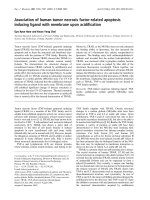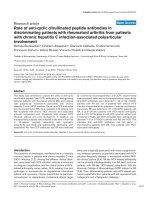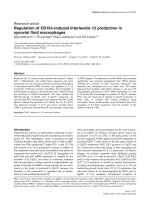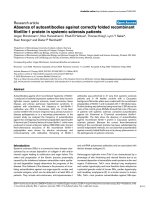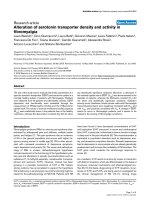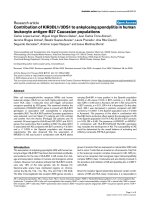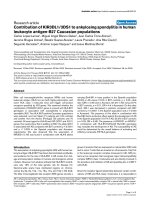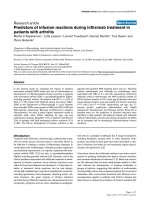Báo cáo y học: " Absence of xenotropic murine leukaemia virusrelated virus in UK patients with chronic fatigue syndrome" docx
Bạn đang xem bản rút gọn của tài liệu. Xem và tải ngay bản đầy đủ của tài liệu tại đây (609.92 KB, 10 trang )
RESEARC H Open Access
Absence of xenotropic murine leukaemia virus-
related virus in UK patients with chronic fatigue
syndrome
Harriet CT Groom
1
, Virginie C Boucherit
1
, Kerry Makinson
2
, Edward Randal
2
, Sarah Baptista
2
, Suzanne Hagan
3
,
John W Gow
3
, Frank M Mattes
4
, Judith Breuer
5
, Jonathan R Kerr
2
, Jonathan P Stoye
1
, Kate N Bishop
1*
Abstract
Background: Detection of a retrovirus, xenotropic murine leukaemia virus-related virus (XMRV), has recently been
reported in 67% of patients with chronic fatigue syndrome. We have studied a total of 170 samples from chronic
fatigue syndrome patients from two UK cohorts and 395 controls for evidence of XMRV infection by looking either
for the presence of viral nucleic acids using quantitative PCR (limit of detection <16 viral copies) or for the
presence of serological responses using a virus neutralisation assay.
Results: We have not identified XMRV DNA in any samples by PCR (0/299). Some serum samples showed XMRV
neutralising activity (26/565) but only one of these positive sera came from a CFS patient. Most of the positive sera
were also able to neutralise MLV particles pseudotyped with envelope proteins from other viruses, including
vesicular stomatitis virus, indicating significant cross-reactivity in serological responses. Four positive samples were
specific for XMRV.
Conclusions: No association between XMRV infection and CFS was observed in the samples tested, either by PCR
or serological methodologies. The non-specific neutralisation observed in multiple serum samples suggests that it
is unlikely that these responses were elicited by XMRV and highlights the danger of over-estimating XMRV
frequency based on serological assays. In spite of this, we believe that the detection of neutralising activity that did
not inhibit VSV-G pseudotyped MLV in at least four human serum samples indicates that XMRV infection may
occur in the general population, although with currently uncertain outcomes.
Background
In 2006 , pursuing a link between prostate cancer and an
inherited mutation in the RNASEL gene, Urisman and
colleagues identified a novel gammaretrovirus [1]. Us ing
PCR methodology, this virus was shown to be present in
9/86 (10%) prostate tumours examined. It showed close
sequence similarity to xenotropic murine endogeno us
retrovirus elements and was thus named xenotropic
murine leukaemia virus related virus (XMRV). A subse-
quent study demonstrated receptor usage typical of
murine xenotropic virus [2]. Phylogenetic analyses place
XMRV firmly within the murine endogenous retro-
viruses [3] even though no identical el ement has so far
been identified within the mouse genome [4]. More
recently, additional groups of samples from patients
with prostate can cer have been examined for the pre-
sence of XMRV with both positive [5] and negative [6,7]
results.
Very recently, a paper reporting the PCR detection of
XMRV in PBMC from 68/101 patients with chronic fati-
gue syndrome (CFS) has been published [8]. Replicati ng
virus could be isolated from stimulated PBMC with
sequences almost, but not quite iden tical to the viruses
isolated from prostate cancer patients. Providing appar-
ently compelling evidence against the possib ility of
laboratory contamination, a number of the patients were
shown to have mounted an immune response against
XMRV. Interestingly, around 4% of control patients
appeared to harbour the virus [8].
* Correspondence:
1
Division of Virology, MRC National Institute for Medical Research, The
Ridgeway, Mill Hill, London NW7 1AA, UK
Groom et al. Retrovirology 2010, 7:10
/>© 2010 Groom et al; licensee BioMed Central Ltd. This is an Open Access article distributed under the terms of the Creative Co mmons
Attribution Licens e ( nses/by/2.0 ), which permits unrestricted use, distribution, and reproduct ion in
any medium, provided the original work is properly cited.
Replication of these results and the possible identifica-
tion of roles for XMRV in the aetiology of prostate can-
cerand/orCFSwouldbeofgreat medical significance.
Detection of XMRV m ight provide potentially useful
diagnostic tools and might also suggest therapeutic ave-
nues for treatment. Further, widespread distribution of a
potentiallypathogenicviruswouldhaveimportant
implications concerning its role as a co-factor in other
conditions and in the safety of t he blood supply. We
therefore set out to investigate the distribution of
XMRV in UK CFS patients, using PCR to search for the
presence of XMRV DNA and neutralisation assays to
detect an anti-XMRV immune response. In this study
we did not find any association between XMRV infec-
tion and CFS.
Methods
Sample collection
Samples from the following three centres were tested; St
George’ s University of London (SGUL), Barts and the
London H ospital Trust (BLT) and Glasgow Caledonian
University (GC).
The SGUL cohort comprised 142 adult CFS patients
and 157 healthy blood donors. Both groups were aged
between18and65,andthemaletofemaleratioswere
45:97 (CFS) and 43:114 (blood donors). A t the time of
sampling, 2003-2008, blood was collected into three
tubes (an EDTA blood tube for DNA preparation; a
Paxgene tube for RNA preparation and a plain tube for
serum preparation from clotted blood). CFS patients
were recruited from clinics in Bristol, Dorset, London,
Birmingham, Norfolk and Epsom, and all patients ful-
filled diagnostic criteria of Fukuda et al. [9]. Blood sam-
ples were taken between 1.5 and 4 years following
diagnosis. Healthy normal blood donors were enrolled
from the National Blood Service (NBS), in Dorset, UK.
All subjects p rovided informed consent, and these stu-
dies were approved by Wandsworth Research Ethics
Committee, St George’ s Hospital, Cranmer Terrace,
London SW17 0RE.
The BLT cohort comprise d 226 anonymised serum
samples taken in 2008-2009 (57 from the antenatal
clinic; 58 with haematological disorders; 55 liver patients
and 56 from the renal clinic). Clotted blood was sepa-
rated by centrifugation, and the serum supernatant was
removed, stored at -20°C and defrosted once. Ethical
approval for the use of these samples for assay develop-
ment was issued by UCLH NHS trust and adopted by
chairman’s action at BLT.
The GC cohort comprised 28 CFS patients (20 sera
and 8 plasma samples) and 12 controls (8 sera and 4
plasma samples) from the West of Scotland catchment
area . CFS patients were aged between 28 and 79, with a
male to female ratio of 16:12. Samples were collected
between 1995 and 2003. Controls were aged between 23
and 63, with a male to female ratio of 7:5. Samples were
collected between 2002 and 2004. Some controls were
relatives of the patients, and some were hospital staff
volunteers.AllpatientsmettheFukudacriteria(9).
Ethical permissi on for blood samples to be analysed for
the presence of viruses was granted by Southern General
Hospital NHS Trust Local Ethics Committee.
PCR
Genomic (g)DNA was prepared from PBMC from SGUL
patients and controls using the QIAamp DNA mini kit
(Qiagen) and amplified using the RepliG Ultrafast Mini
Kit (Qiagen), which provides highly uniform amplification
of all sequences, wi th negligible sequence bias. The con-
centrations after amplification ranged from 108 - 586 ng/
μl. Initially, 48 CFS patient gDNA samples were screened
by single-round PCR for gag and env genes, as well as
GAPDH, as outlined by Lombardi et al. [8] (Table 1). This
PCR was performed in a 50 μl reaction volume consisting
of 25 μl amplitaq gold PCR mastermix and a final DNA
concentration of 2-5 ng/μl. Cycling was modified as
appropriate to our mastermix; 95°C for 5 min, (95°C for
30 sec, 57°C for 30 sec, and 72°C for 60 sec) for 45 cycles,
hold at 72°C for 7 min, store at 4°C. Products were visua-
lized on 3% agarose gels by ethidium bromide staining. As
we did not amplify any products using this PCR, we devel-
oped two more sensitive real-time qPCR assays which tar-
geted 2 regions of the env gene, beginning at nt 6173 and
Table 1 Primer sequences used in XMRV-specific PCRs
Primer Sequence Reference
419F gag ATCAGTTAACCTACCCGAGTCGGAC Lombardi
et al, 2009
1154R gag GCCGCCTCTTCTTCATTGTTCT Lombardi
et al, 2009
5922F env GCTAATGCTACCTCCCTCCTGG Lombardi
et al, 2009
6273R env GGAGCCCACTGAGGAATCAAAACAGG Lombardi
et al, 2009
hGAPDH-66F GAAGGTGAAGGTCGGAGTC Lombardi
et al, 2009
hGAPDH-291R GAAGATGGTGATGGGATTTC Lombardi
et al, 2009
Real-time PCR
6173 env F GGCATACTGGAAGCCATCATCATC
6173 env R CCTGACCCTTAGGAGTGTTTCC
6173 env probe ATGGGACCTAATTTCC
6682 env F GTGCTGGCTGTGTCTAGTATCG
6682 env R GCAGAGGTATGGTTGGAGTAAGTAC
6682 env probe ACGGCCACCCCTTCGT
Groom et al. Retrovirology 2010, 7:10
/>Page 2 of 10
6682, respectively (Table 1). These were used to screen
samples of gDNA (prepared from PBMC) or cDNA (pre-
pared from total RNA extracted using the Paxgene system
from Preanalytix, UK) from CFS and normal blood
donors. In total, 136 CFS gDNA and 140 CFS cDNA sam-
ples and 95 control gDNA and 141 control cDNA samples
were analysed, such that all 142 CFS patients and 157
blood donors were screened for XMRV using these assays
in either genomic DNA, cDNA or both. GAPDH was also
amplified as a control using a commercial primer and
probe set (Hs_99999905_m1 from Applied Biosystems).
Real-time qPCR reactions were performe d in 10 μltotal
volume, consisting of 5 μlPCRmastermix,0.5μl (20×)
Taqman primers/probe mix, 4.5 μlsample(forgDNA,1μl
gDNA (100-590 ng) and 3.5 μl DEPC-treated water
(Ambion);forcDNA,4.5μl cDNA). Cycling times and
temperatures were as follows. Initial denaturation
occurred for 10 min at 95°C, followed by 40 cycles of
denaturation at 95°C for 15secandcombinedprimer
annealing/extension at 60°C for 1 min. Data were dis-
played using SDS 1.3.1 software (ABI).
Plasmids
VP62 XMRV clone was a gift of Robert Silverman [2].
HG1 is a replication-incompetent XMRV clone con-
structed by site-directed mutagenesis of VP62 (the packa-
ging signal was removed by deleting nucleotides 293-388,
as numbered in GenB ank EF185282; and nucleo tides
7720-8108 were replaced by a BsrG1 site to remove the
U3 region). Moloney-MLV Gag-Pol was expressed from
KB4, a vector synthesized by cloning the gag-pol region
from pMD-MLV Gag Pol [10] into pcDNA3.1. Viral
genomic RNA was expressed f rom an MLV-based retro-
viral vector encoding b-galactosidase (LTR-LacZ [10]),
and envelope proteins were encoded by constructs for
either NZB xenotropic envelope, MLV (X) (a gift of Mas-
simo Pizzato), Moloney-MLV env (MOSAF, a gift of
Yasu Takeuchi), Friend-MLV env [ 10], or the G-protein
from vesicular stomatitis virus (VSV-G) [11].
Virus production
Replication defective XMRV virus was prepared for neu-
tralisation assays by co-transfecting 293T cells with
HG1 and LTR-LacZ. Pseudotyped MLV was prepared
by co-transfecting 293T cells with KB4, LTR-LacZ and
an envelope-encoding plasmid (either MLV(X ), MOSAF,
Friend or VSV-G). After ~18 hours, cells were washed,
and fresh media was added for a further ~24 hours,
before viral supernatants were harveste d, filtered, and
the viral titre was measured by ELISA for RT activity
(Cavidi tech). Viral stocks were titrated on D17 cells, an
established, easily infectable dog cell line, or NIH-3T3
cells for Friend- and Moloney- pseudotyped MLV. After
48 hours, the cells were assayed for b-galactosidase
activity using the Galacto-Star system (Applied Biosys-
tems). The amount of virus to be used in the neutralisa-
tion assays was determined as the volume of
supern atant added to 3.5 × 10
3
cells that resulted in ~4
×10
4
counts per second of chemiluminescence.
Neutralisation assays
Neutralisation assays were performed as reported in
[12]. Monoclo nal antibodies to MLV Env proteins
(shown in Table 2) were gifts from Leonard Evans and
have been previously described [13,14]. They were pro-
vided and used as untreated hybri doma cell superna -
tants that were serially dilu ted two-fold before adding to
virus to assess neutralisati on activity as for serum,
detailed below. Serum sample s were heat inactivated at
56°C for 30 min. 5 μl serum were then added to 95 μl
media in a 96-well tissue culture p late, and samples
were serially diluted two-fold, leaving 50 μl at each dilu-
tion. 50 μl virus-containing supernatant were then
added to each well, and the plate was incubated at 37°C
for 1 hour. Following incubation, 100 μl containing 3.5
×10
3
D17 cells (or NIH-3T3 cells for Friend or Molo-
ney-MLV neutralisation) w ere added to each well, and
the plate was incubated at 37°C. After 48 hours the cells
were lysed, and b-galactosidase activity was measured.
Infectivity corresponded to counts per second of
chemiluminescence.
Results
PCR screening
Lombardi et al. have recently detected XMRV DNA in
67% of CFS patients by PCR [8]. To confirm an associa-
tion o f XMRV with this disease, we performed PCR for
gag, env and GAPDH on 48 (of 142) CFS patient gDNA
samples from SGUL using the previously published
Table 2 Neutralisation properties of different monoclonal
antibodies against XMRV and MLV pseudotyped with
three different envelopes.
Neutralisation of
Hybridoma
1
Raised in Isotype XMRV MLV(X) Friend Moloney
83A25’ Rat IgG2A Y (88) Y (89) ND ND
24-7 Mouse IgMK N N ND ND
48 Mouse IgG2A N N Y (95) Y (83)
538 Mouse IgM N N N Y (63)
603 Mouse IgM N Y (96) N ND
609 Mouse IgM Y (71) N ND ND
610 Mouse IgM N Y (64) ND ND
613 Mouse IgM N Y (91) ND ND
615 Mouse IgM N N ND ND
Y indicates neutralisation; N indicates no neutralisation; ND is not determined
The number in brackets refers to the percentage neutralisation at the least
diluted antibody concentration.
1
See references [13] and [14] for description of hybridoma cell lines
Groom et al. Retrovirology 2010, 7:10
/>Page 3 of 10
single-round PCR methodology (Table 1 and [8]. How-
ever, although all samples were positive for GAPDH, we
found no evidence of XMRV DNA in any of the samples
(data not shown). In case we were missing low levels of
viral DNA, we devised a more sensitive qPCR-based
approach. To test the sensitivity of this method, tripli-
cate, serial 1:10 dilutions of VP62 plasmid encoding the
full length XMRV genome were added to PBMC DNA
from a healthy donor and tested by Taqman PCR with
either env 6173 or env 6682 primers (Table 1). All repli-
cates calculated to contain 16 copies of XMRV routinely
yielded a product within 37 cycles whereas only one of
three replicates of the next dilution scored positive (Fig-
ure 1). We concluded that our assay was capable of reli-
ably detecting as little as 16 copies of proviral DNA and
was therefore likely to be as sensitive, if not more so,
than the assays previously used [8]. We the n tested th e
entire SGUL panel of 142 CFS sample s and 15 7 of th e
control samples (either gDNA, cDNA or both) with
bot h env 6173 and env 6682 primers. Althou gh positive
for GAPDH, all samples were negative for XMRV. To
exclude the possibility of specific sample-mediated PCR
inhibition, we spiked 3 normal control cDNAs, which
had previously tested negative for XMRV nucleic acid,
with XMRV VP62 DNA, to a final conc entration of 2.3
×10
-6
ng/μl and repeated the qPCR using both env
6173 and env 6682 primer sets. We successfully ampli-
fied the VP62 in t hese reactions, proving that the PCR
should have amplified XMRV from the patient samples
if it was present.
Neutralisation assays
In light of the negative data obtained using PCR assays,
we set out to search for evidence of XMRV infection
using a second method. Viral infect ion can elicit a neu-
tralising antibody response [12]. Demonstration of such
a neutralising activity can be taken as evidence for a
viral infection, perhaps in cell types that were not
sampled in blood. Defining n eutralisation is difficult in
the a bsence of known positiveandnegativesera.How-
ever, a number of neutralising monoclonal antibodies
directed against the Env protein of murine retroviruses
have been described [13,14]. We therefore obtained sev-
eral of these (gifts of Leonard Evans) and tested them
for neutralisation of XMRV and NZB xenotropic MLV
(X) as well as ecotropic Friend and Moloney MLV
(Table 2) by assaying for a reduction in virus infectivity
following incubation of virus-containing supernatant
Figure 1 Sensitivity of PCR screening for XMRV in PBMC DNA. VP62 plasmid was serially diluted 1:10 into PBMC DNA from a healthy donor
and tested by Taqman PCR with env 6173 primers and probe. The final amount of VP62 DNA in the reaction was A, 2.3 × 10
-2
ng, B, 2.3 × 10
-3
ng, C, 2.3 × 10
-4
ng, D, 2.3 × 10
-5
ng, E, 2.3 × 10
-6
ng, F, 2.3 × 10
-7
ng or G, 2.3 × 10
-8
ng. The limit of sensitivity was 2.3 × 10
-7
ng (shown by
trace F) which equates to 16 molecules of VP62 XMRV clone.
Groom et al. Retrovirology 2010, 7:10
/>Page 4 of 10
with the monoclonal antibody. As anticipated, some
monoclonal antibodies were able to neutralise XMRV
(83A25’ and 609) whilst others had no effect on XMRV
infectivity. Interestingly, we identified three monoclonal
antibodies that neutralised MLV(X) but not XMRV
(603, 610 and 613) and one that neutralised XMRV but
not MLV(X) (609). These reagents may therefore be
useful tools with which to distinguish XMRV from
other xenotropic MLVs in future investigations. From
these experiments we defined t wo negative (603 and
613) and one positive ( 83A25’ ) antibody controls for
further experiments. To validate the neut ralisation assay
and examine the possible range of responses to “normal
serum” , we tested neutralisation using a panel of 226
serum samples from BLT. Previous investigations have
detected XMRV DNA in ~1-6% of control samples
[5,6,8]. Of our panel only a handful showed possible
neutralisation activity, giving curves similar to that
showninFigure2A,withreductions in viral i nfectivity
similar or greater than that seen with the positive con-
trol, monoclonal 83A25’.Over90%ofthesamples
tested had less than a 2-fold effect on infectivity (Figure
cpscps
AB
Figure 2 Examples of BLT positive serum neutralisation activity. A, Infectivity of XMRV (measured as counts per second of
chemiluminescence produced from b-galactosidase activity) after incubation with patient serum or hybridoma cell supernatant. Infectivity is
plotted against the reciprocal dilution of the BLT serum (black circles, top panel, sample Q488, bottom panel, sample Q610; triangles, negative
control, monoclonal 603; squares, positive control, monoclonal 83A25’). The dashed line indicates viral infectivity in the absence of sera. B,
Infectivity data for viruses with four different envelopes (circles, XMRV; squares, MLV(X); triangles, Friend-MLV; crosses, VSV-G) after incubation with
patient serum. Data were normalised by setting the infectivity for each virus in the absence of patient serum at 100%, and plotted against the
reciprocal of serum dilution for two positive sera, top panel sample Q488 and bottom panel sample Q610.
Groom et al. Retrovirology 2010, 7:10
/>Page 5 of 10
3A). From these data, we have defined a positive as a
sample that reduces viral infectivity by at least 70% at a
dilution of 1/40 and gives a reduction of 50% at a 1/80
dilution. According to this definition, the BLT sample
set contains 3 neutralising sera, identifying 1.3% of sam-
ples as positive.
To confirm that the neutralisation activity demon-
strated was specific for XMRV, we tested a subset of sera
for neutralisation of XMRV alongside MLV particles
pseudotyped with different envelope pro teins from MLV
(X), Friend-MLV or VSV. As shown in Figure 2B, of
these four virus preparations, only XMRV infectivit y was
inhibited by any of the sera tested. Even the infectivity of
part icles expressing the closely related MLV(X) envelope
that is 94% identical to XMRV was unaffected by sera
that inhibited XMRV (Figure 2B, squares). Thus, it seems
that the neutralising activity is specific for XMRV.
We therefore felt this assay was sensitive and specific
enough to examine the neutralising ability of the SGUL
cohort of blinded patient serum samples. After unblind-
ing the samples, it emerged that of the 142 CFS patient
sera tested none was positive as defined by the criteria
above (Figure 3B). These results suggested that there
was no link between XMRV and CFS. By contrast, the
control g roup of 157 blood donors contained 22
positives, a frequency of 14%, considerably higher than
that seen in the BLT group (Figure 3C). It was also
noticeable that the neutralising activity of all but one of
the SGUL positive samples was much stronger than the
BLT positive samples (co mpare Figure 2A with Figure
4A). In fact, most of the SGUL positive sera reduced
XMRV infectivity by 100 fold at both 1/40 and 1/80
dilutions. Intriguingly, many of these serum samples
were collected from a single blood donation session.
Some samples from this session, however, were negative.
Surprisingly, PCR analyses of DNA samples correspond-
ing to the positive sera from the SGUL controls were
uniformly negative. We therefo re investigated the sp eci-
ficity of this response b y testing 21 of the positive sera
for neutralisation of MLV pseudotyped with the envel-
ope proteins from MLV(X), Friend-MLV or VSV. In
every case, the serum wa s able to neutralise addition al
viruses to XMRV, including particles pseudotyped with
thenon-retroviralenvelopefromVSV(Figure4Band
Table 3). This implied that the strong pos itive neutralis-
ing activity demonstrated by the SGUL blood donor
controls was not specific to XMRV , and in all likelin ess
was not elicited by this virus.
To test whether the SGUL cohort of CFS patients was
unique, we also tested 40 samples (including some
A
B
%
%
%
C
Figure 3 Distribution of neutralisation activity in three samples sets. Numbers of patients showing different degrees (>70% , 50-70% and
<50%) of neutralisation of XMRV infectivity are shown for the 1/40 and 1/80 serum dilutions. A, Total BLT cohort (n = 226); B, SGUL CFS cohort
(n = 142); C, SGUL control blood donor cohort (n = 157).
Groom et al. Retrovirology 2010, 7:10
/>Page 6 of 10
plasma samples as well as sera) from a separate CFS
cohort in our neutralisation assay. This GC cohort
revealed a solitary positive out of 28 CFS samples
(3.6%), and no positives out of 12 control samples. The
positive CFS patient serum was also able to neutralise
MLV pseudo typed with either MLV(X ) or Friend envel-
opes, although interestingly, it was not able to neutralise
VSV-G pseudotyped MLV (Table 3). Neutralisation data
from the different cohorts are summarized in Table 4.
Thus, in summary, we f ound no association of XMRV
with either CFS cohort.
Discussion
We set out with the intention of confirming the results of
Lombardi et al. [8] concerning the association of XMRV
with CFS. In tot al, we tested 142 CFS samples for both
the presence of XMRV DNA in PBMCs by PCR and for
the presence of neutralising antibo dies against XMRV in
our viral neutralisation assay, and a further 28 CFS sam-
ples for neutralising antibodies only. However, in con-
trast to Lombardi et al., we found no evidence of XMRV
DNA in any patient sampl es tested, and only a single
neutralisation-positive patient serum. Our findings
cpscps
AB
Figure 4 Examples of SGUL positi ve serum neutralisation activity. A, Infectivity of XMRV (measured as counts per second of
chemiluminescence produced from b-galactosidase activity) after incubation with patient serum or hybridoma cell supernatant. Infectivity is
plotted against the reciprocal dilution of the SGUL serum (black circles, top panel, sample Q321, bottom panel, sample Q323; triangles, negative
control, monoclonal 613; squares, positive control, monoclonal 83A25’). The dashed line indicates viral infectivity in the absence of sera. B,
Infectivity data for viruses with four different envelopes (circles, XMRV; squares, MLV(X); triangles, Friend-MLV; crosses, VSV-G) after incubation with
patient serum. Data were normalised by setting the infectivity for each virus in the absence of patient serum at 100%, and plotted against the
reciprocal of serum dilution for two positive sera, top panel sample Q321 and bottom panel sample Q323.
Groom et al. Retrovirology 2010, 7:10
/>Page 7 of 10
therefore appear inconsistent with the previous report
that isolated XMRV from PBMCs of CFS patients. We
are confident that, although we are unable to replicate
the PCR detection of XMRV in PBMC DNA from CFS
patients, our PCR assay is more sensitive than the pub-
lished single round PCR method and should have pos-
sessed the necessary sensitivity to detect XMRV if it was
indeed present (Figure 1). Furthermore, we were able to
detect neutralising activity in one patient and in several
control serum samples (Table4andFigure3),implying
that our neutralisation assay also has the required sensi-
tivity. The lack of neutralising activity in CFS samples
compared to controls could reflect an i nability to mount
an immune response in these patients. However, in that
case, the virus would be expecte d to replicate to higher
levels in CFS patients making it easier to detect by PCR.
As we could not detect any evidence of XMRV infection
by our PCR assays, we think this is an unlikely
explanation. Thus, in o ur cohorts, we found no associa-
tion of XMRV with CFS. This is in stark contrast to the
result of Lombardi et al. [ 8]. However, it is thought likely
that the term CFS defin es multiple diseases [15-17], and
it remains formally possible that a fraction of these are
associated with XMRV. During the submission of this
manuscript another report was published by Erlwein et
al. that also failed to detect XMRV in CFS patients by
PCR [18]. The publication of these results has promoted
much discussion and controversy amongst CFS research-
ers and patients alike, and has highlighted the need for
additional investigations in this area. Following the find-
ings reported here, it would seem a prudent next step for
subsequent studies to compare samples and protocols
between different laboratories around the world.
There have also been c onflicting reports describing
the association of XMRV with prostate cancer. Two stu-
dies from the USA [1,5] have found an increased
Table 3 Neutralisation properties of different human sera against XMRV and MLV pseudotyped with three different
envelopes.
Neutralisation of
Sample ID XMRV MLV(X) Friend VSV XMRV detected by PCR
Barts and the London
Q488 + - - - ND
Q610 + - - - ND
Q663 + ND ND ND ND
St George’s University of London
Q302 ++ ++ ++ ++ no
Q304 ++ ++ ++ ++ no
Q305 ++ ++ ++ ++ no
Q306 ++ ++ ++ ++ no
Q307 ++ + + - no
Q308 ++ ++ ++ ++ no
Q309 ++ ++ ++ ++ no
Q310 ++ ++ ++ ++ no
Q311 ++ + + + no
Q312 ++ ++ ++ ++ no
Q313 ++ ++ ++ ++ no
Q314 ++ ND ND ++ no
Q315 ++ ++ ++ ++ no
Q316 ++ ++ ++ ++ no
Q317 ++ ++ ++ ++ no
Q319 ++ ND ND ++ no
Q320 ++ ++ ++ ++ no
Q321 ++ ++ ++ ++ no
Q323 ++ ++ ++ ++ no
Q324 ++ ++ ++ ++ no
Q326 ++ ND ND ND no
Q372 + - - + no
Glasgow Calendonian University
Q125 + ++ ++ - ND
+ indicates neutralising activity; ++ indicates strong neutralising activity; - indicates no neutralising activity; ND is no determined.
Groom et al. Retrovirology 2010, 7:10
/>Page 8 of 10
prevalence of the virus in prostate cancer patients,
although they differed as to whether this was dependent
on the RNASEL genotype of the patie nt. Conversely,
two German studies failed to establish a link between
the virus and disease [6,7]. Nevertheless, XMRV has
been detected in the control groups in multiple investi-
gations [5,6,8], with the incidence varying between 1
and 6%. In our serological studies we have also identi-
fied neutralising activity against XMRV in around 4% of
all the samples examined. Remarkably many (but not
all) of the seropositive samples were identified in a rela-
tively small group of blood donors within the SGUL
cohort, possibly suggesting a local outbreak of infe ction.
There is no evidence that this group are related or that
they have a particularly high r isk of acquiring a retro-
viral infection. Therefore, an outbreak of this kind
seems unlikely. Moreover, all but one of the positive
samplesfromtheSGULsetwetestedwerealsoableto
neutralise MLV pseudotyped with the envelope protein
fromVSV(Table3).Theoneserumthatfailedtoneu-
tralise VSV-G pseudotyped MLV was, however, able to
neutralise MLV particles pseudotyped with other retro-
viral envelopes. We therefore consider these positives
from healthy blood donors to be non-specific cross
reacting responses. The remaining four positive samples
from the BLT and GC cohorts had much weaker neu-
tralisation activities and did not neutralise VSV-G p seu-
dotyped MLV, although, again, the positive serum from
GC did neutralise particles expressing other retroviral
envelopes (Table 3). Although we cannot rule out the
possibility that the activity of these samples against
XMRV is also non-specific, one possible explanation for
these serological findings remains that XMRV infection
has occurred in around one percent of the population.
This figure is consistent with the general prev alen ce in
control samples previously reported. Given the common
oncogenic properties of gammaretroviruses [19] and the
report ed link betwee n XMRV and prostate cancer [1,5],
such an observation might be of considerable signifi-
cance, particularly for the blood transfusion services. It
should, however, be noted that we have so far been
unable to reliably detect bacterially expressed XMRV
Gag proteins by using these sera in immunoblotting
experiments. It is therefore conceivable that these neu-
tralising activities were not elicited by XMRV. Further
investigations are required to determine the nature of
these antiviral activities.
Conclusions
In summary, we have studied 299 DNA samples and
565 serum samples for evidence of XMRV infection. We
have not identified XMRV DNA in any samples by PCR,
however, some serum samples were able to neutralise
XMRV infectivity in our assay. Only one of these posi-
tive sera came from a CFS patient, implying that t here
is no association between XMRV infection and CFS.
Furthermore, most of the positive sera were also able to
neutralise MLV particles pseudotyped with other envel-
ope proteins, indicating there may be cross reactivity
with other retroviruses and even other enveloped
viruses. It therefore seems unlikely that these responses
were elicited by XMRV. However , the detection of neu-
tralising activity that did not neutralise VSV-G pseudo-
typed MLV in at least four human sera may indicate
that XMRV infection does occur at in the general popu-
lation, a lthough the outcome of such infections is cur-
rently uncertain.
Acknowledgements
This work was supported by the UK Medical Research Council (file reference
(KB) U117592729 and (JS) U117512710), The Wellcome Trust (grant ID
084955) and CFS Research Foundation, UK. We acknowledge The
Cunningham Trust for funding to SH. KNB is a Wellcome Trust Career
Development Fellow. We thank Leonard Evans for anti-MLV Env hybridoma
supernatants and Robin Weiss and Nigel Temperton for helpful advice about
neutralisation assays. We thank the following clinicians who provided
patients for the present study; Dr Selwyn Richards, Dr Janice Main, Prof
David J Nutt, Dr David Honeybourne, Dr Luis Nacul, Dr Amolak Bansal, Prof
Peter Behan and Dr Abhijit Chaudhuri, and Mark Quinlivan for retrieving
samples.
Author details
1
Division of Virology, MRC National Institute for Medical Research, The
Ridgeway, Mill Hill, London NW7 1AA, UK.
2
CFS Group, Division of Cellular &
Molecular Medicine, St George’s University of London, Cranmer Terrace,
London SW17 0RE, UK.
3
The Centre for Forensic Investigation, Dept of
Biological and Biomedical Sciences, Glasgow Caledonian University, Glasgow
G4 0BA, UK.
4
Department of Virology, Barts and The London NHS Trust, 18
Newark St, Whitechapel, London E1 2ES, UK.
5
Division of Infection and
Immunity, University College London, Windeyer Building, 46 Cleveland St,
London W1T 4JF, UK.
Authors’ contributions
JK, JS and KB conceived and designed the investigation. HG and VB carried
out the viral neutralisation assays and analysed the data. KM, ER, SB and JK
performed the PCR analyses. SH, JG, FM, JB and JK provided patient samples.
JS and KB analysed the data and drafted the manuscript. All authors read
and approved the final manuscript.
Competing interests
The authors declare that they have no competing interests.
Table 4 Summary of number of positive sera with XMRV
neutralisation properties
Sample cohort Positive Total number
Barts and the London
Control 3 226
St Georges University of London
CFS 0 142
Control 22 157
Glasgow Caledonian University
CFS 1 28
Control 0 12
Groom et al. Retrovirology 2010, 7:10
/>Page 9 of 10
Received: 11 January 2010
Accepted: 15 February 2010 Published: 15 February 2010
References
1. Urisman A, Molinaro RJ, Fischer N, Plummer SJ, Casey G, Klein EA, Malathi K,
Magi-Galluzzi C, Tubbs RR, Ganem D, Silverman RH, DeRisi JL: Identification
of a novel Gammaretrovirus in prostate tumors of patients homozygous
for R462Q RNASEL variant. PLoS Pathog 2006, 2:e25.
2. Dong B, Kim S, Hong S, Das Gupta J, Malathi K, Klein EA, Ganem D,
Derisi JL, Chow SA, Silverman RH: An infectious retrovirus susceptible to
an IFN antiviral pathway from human prostate tumors. Proc Natl Acad Sci
USA 2007, 104:1655-1660.
3. Jern P, Stoye JP, Coffin JM: Role of APOBEC3 in genetic diversity among
endogenous murine leukemia viruses. PLoS Genet 2007, 3:2014-2022.
4. Coffin JM, Stoye JP: Virology. A new virus for old diseases?. Science 2009,
326:530-531.
5. Schlaberg R, Choe DJ, Brown KR, Thaker HM, Singh IR: XMRV is present in
malignant prostatic epithelium and is associated with prostate cancer,
especially high-grade tumors. Proc Natl Acad Sci USA 2009,
106:16351-16356.
6. Fischer N, Hellwinkel O, Schulz C, Chun FK, Huland H, Aepfelbacher M,
Schlomm T: Prevalence of human gammaretrovirus XMRV in sporadic
prostate cancer. J Clin Virol 2008, 43:277-283.
7. Hohn O, Krause H, Barbarotto P, Niederstadt L, Beimforde N, Denner J,
Miller K, Kurth R, Bannert N: Lack of evidence for xenotropic murine
leukemia virus-related virus (XMRV) in German prostate cancer patients.
Retrovirology 2009, 6:92.
8. Lombardi VC, Ruscetti FW, Das Gupta J, Pfost MA, Hagen KS, Peterson DL,
Ruscetti SK, Bagni RK, Petrow-Sadowski C, Gold B, Dean M, Silverman RH,
Mikovits JA: Detection of an Infectious Retrovirus, XMRV, in Blood Cells
of Patients with Chronic Fatigue Syndrome. Science 2009, 326:585-589.
9. Fukuda K, Straus SE, Hickie I, Sharpe MC, Dobbins JG, Komaroff A: The
chronic fatigue syndrome: a comprehensive approach to its definition
and study. International Chronic Fatigue Syndrome Study Group. Ann
Intern Med 1994, 121:953-959.
10. Mothes W, Boerger AL, Narayan S, Cunningham JM, Young JA: Retroviral
entry mediated by receptor priming and low pH triggering of an
envelope glycoprotein. Cell 2000, 103:679-689.
11. Bock M, Bishop KN, Towers G, Stoye JP: Use of a transient assay for
studying the genetic determinants of Fv1 restriction. J Virol 2000,
74:7422-7430.
12. Temperton NJ, Hoschler K, Major D, Nicolson C, Manvell R, Hien VM, Ha
do Q, de Jong M, Zambon M, Takeuchi Y, Weiss RA: A sensitive retroviral
pseudotype assay for influenza H5N1-neutralizing antibodies. Influenza
Other Respi Viruses 2007, 1:105-112.
13. Chesebro B, Britt W, Evans L, Wehrly K, Nishio J, Cloyd M: Characterization
of monoclonal antibodies reactive with murine leukemia viruses: use in
analysis of strains of Friend MCF and Friend ecotropic murine leukemia
virus. Virology 1983, 127:134-148.
14. Evans LH, Morrison RP, Malik FG, Portis J, Britt WJ:
A neutralizable epitope
common to the envelope glycoproteins of ecotropic, polytropic,
xenotropic, and amphotropic murine leukemia viruses. J Virol 1990,
64:6176-6183.
15. Hickie I, Davenport T, Vernon SD, Nisenbaum R, Reeves WC, Hadzi-
Pavlovic D, Lloyd A: Are chronic fatigue and chronic fatigue syndrome
valid clinical entities across countries and health-care settings?. Aust N Z
J Psychiatry 2009, 43:25-35.
16. Kato K, Sullivan PF, Evengard B, Pedersen NL: A population-based twin
study of functional somatic syndromes. Psychol Med 2009, 39:497-505.
17. Kerr JR, Petty R, Burke B, Gough J, Fear D, Sinclair LI, Mattey DL, Richards SC,
Montgomery J, Baldwin DA, Kellam P, Harrison TJ, Griffin GE, Main J,
Enlander D, Nutt DJ, Holgate ST: Gene expression subtypes in patients
with chronic fatigue syndrome/myalgic encephalomyelitis. J Infect Dis
2008, 197:1171-1184.
18. Erlwein O, Kaye S, McClure MO, Weber J, Wills G, Collier D, Wessely S,
Cleare A: Failure to Detect the Novel Retrovirus XMRV in Chronic Fatigue
Syndrome. PLoS ONE 2010, 5:e8519.
19. Rosenberg N, Jolicoeur P: Retroviral pathogenesis. Retroviruses Cold Spring
Harbor Press, Cold Spring Harbor, NYCoffin JM, Hughes SH, Varmus HE
1997, Chapter 10:475-585.
doi:10.1186/1742-4690-7-10
Cite this article as: Groom et al.: Absence of xenotropic murine
leukaemia virus-related virus in UK patients with chronic fatigue
syndrome. Retrovirology 2010 7:10.
Submit your next manuscript to BioMed Central
and take full advantage of:
• Convenient online submission
• Thorough peer review
• No space constraints or color figure charges
• Immediate publication on acceptance
• Inclusion in PubMed, CAS, Scopus and Google Scholar
• Research which is freely available for redistribution
Submit your manuscript at
www.biomedcentral.com/submit
Groom et al. Retrovirology 2010, 7:10
/>Page 10 of 10
